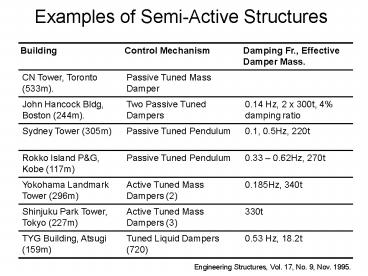Examples of Semi-Active Structures - PowerPoint PPT Presentation
Title:
Examples of Semi-Active Structures
Description:
An Active Mass Damper consists of a mass whose motion (displacement, velocity, ... The two-mass active mass damper damps these two modes (Picture courtesy ... – PowerPoint PPT presentation
Number of Views:67
Avg rating:3.0/5.0
Title: Examples of Semi-Active Structures
1
Examples of Semi-Active Structures
Building Control Mechanism Damping Fr., Effective Damper Mass.
CN Tower, Toronto (533m). Passive Tuned Mass Damper
John Hancock Bldg, Boston (244m). Two Passive Tuned Dampers 0.14 Hz, 2 x 300t, 4 damping ratio
Sydney Tower (305m) Passive Tuned Pendulum 0.1, 0.5Hz, 220t
Rokko Island PG, Kobe (117m) Passive Tuned Pendulum 0.33 0.62Hz, 270t
Yokohama Landmark Tower (296m) Active Tuned Mass Dampers (2) 0.185Hz, 340t
Shinjuku Park Tower, Tokyo (227m) Active Tuned Mass Dampers (3) 330t
TYG Building, Atsugi (159m) Tuned Liquid Dampers (720) 0.53 Hz, 18.2t
Engineering Structures, Vol. 17, No. 9, Nov. 1995.
2
Passive Control Base Isolation
Base isolation is a mature technology, commonly
used in bridges. Pictured left is a base isolator
in use on a building at the Kajima Research
Facility. Pictured on the right are base
isolators used in a viaduct in Nagoya. These
structures rely on (passive) base isolation to
control the structure in the event of ground
motion (Picture credits Steven Williams).
3
Multistep Pendulum Dampers
The Yokohama Landmark Tower, one of the tallest
buildings in Japan relies on multistep pendulum
dampers (2) to damp dominant vibration mode of
0.185 Hz. Pictured on the right is a model of the
pendulum (Picture credits Steven Williams). .
4
Examples Active Mass Damper in the Kyobashi
Seiwa Building
An Active Mass Damper consists of a mass whose
motion (displacement, velocity, acceleration) is
controlled, in this case, by a turn-screw
actuator. Eigenvalue analysis of the structure
shows that the dominant vibration mode is in
transverse direction with a period of 1.13 s. and
second eigenvalue in the torsional direction with
a period of 0.97s. The two-mass active mass
damper damps these two modes (Picture courtesy
BolognaFiere).
5
Passive / Semi-Active Fluid Dampers
Pictured left is a passive fluid damper with
bottom casing containing the bearings and oil
used to absorb seismic energy. Pictured right is
a semiactive damper with variable orifice damping
(Picture credits Steven Williams).
6
The Future Fine-Grained Active Control.
A new class of active dampers based on
Magnetorheological Fluids (fluids capable of
changing their viscosity characteristics in
milliseconds, when exposed to magnetic fields,
courtesy Lord Corp.), coupled with considerable
advances in sensing and networking technology,
present immense potential for fine-grained
real-time control for robust structures. These
control mechanisms render structures resilient to
explosions and failures due to anomalous
conditions such as high-temperature, in addition
to traditional hazards such as high winds and
earthquakes.
7
Active Control Emerging Frontiers
The Dongting Lake Bridge is being retrofitted
with MR dampers to control wind-induced vibration
(picture source Prof. Y. L. Xu, Hong Kong Poly.)































